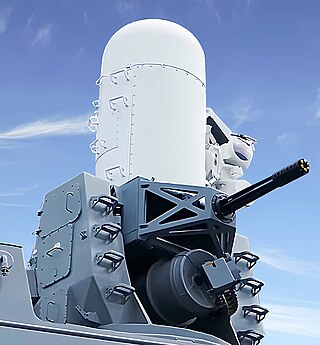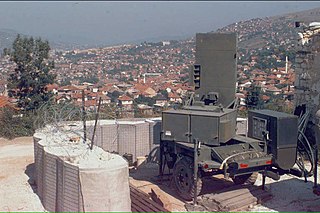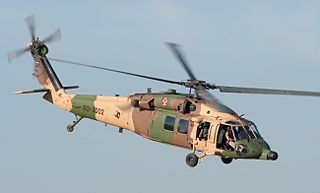Related Research Articles
The AIM-120 Advanced Medium-Range Air-to-Air Missile(AMRAAM) ( AM-ram) is an American beyond-visual-range air-to-air missile capable of all-weather day-and-night operations. It uses active transmit-receive radar guidance instead of semi-active receive-only radar guidance. When an AMRAAM missile is launched, NATO pilots use the brevity code "Fox Three".

The TomahawkLand Attack Missile (TLAM) is a long-range, all-weather, jet-powered, subsonic cruise missile that is primarily used by the United States Navy and Royal Navy in ship and submarine-based land-attack operations.

The Phalanx CIWS is an automated gun-based close-in weapon system to defend military watercraft automatically against incoming threats such as aircraft, missiles, and small boats. It was designed and manufactured by the General Dynamics Corporation, Pomona Division, later a part of Raytheon. Consisting of a radar-guided 20 mm (0.8 in) Vulcan cannon mounted on a swiveling base, the Phalanx has been used by the United States Navy and the naval forces of 15 other countries. The U.S. Navy deploys it on every class of surface combat ship, except the Zumwalt-class destroyer and San Antonio-class amphibious transport dock. Other users include the British Royal Navy, the Royal Australian Navy, the Royal New Zealand Navy, the Royal Canadian Navy, and the U.S. Coast Guard.

Anti-aircraft warfare is the counter to aerial warfare and it includes "all measures designed to nullify or reduce the effectiveness of hostile air action". It includes surface based, subsurface, and air-based weapon systems, associated sensor systems, command and control arrangements, and passive measures. It may be used to protect naval, ground, and air forces in any location. However, for most countries, the main effort has tended to be homeland defence. Missile defence is an extension of air defence, as are initiatives to adapt air defence to the task of intercepting any projectile in flight.

The Boeing YAL-1 airborne laser testbed was a modified Boeing 747-400F with a megawatt-class chemical oxygen iodine laser (COIL) mounted inside. It was primarily designed to test its feasibility as a missile defense system to destroy tactical ballistic missiles (TBMs) while in boost phase. The aircraft was designated YAL-1A in 2004 by the U.S. Department of Defense.

Stealth aircraft are designed to avoid detection using a variety of technologies that reduce reflection/emission of radar, infrared, visible light, radio frequency (RF) spectrum, and audio, all collectively known as stealth technology. The F-117 Nighthawk was the first operational aircraft explicitly designed around stealth technology. Other examples of stealth aircraft include the B-2 Spirit, the B-21 Raider, the F-22 Raptor, the F-35 Lightning II, the Chengdu J-20, and the Sukhoi Su-57.

The Cleveland class was a group of light cruisers built for the U.S. Navy during World War II. They were the most numerous class of light cruisers ever built. Fifty-two were ordered, and 36 were completed, 27 as cruisers and nine as light aircraft carriers. They were deactivated within a few years after the end of the war, but six were converted into missile ships, and some of these served into the 1970s. One ship of the class remains as a museum ship.

Brimstone is a ground or air-launched ground attack missile developed by MBDA UK for the UK's Royal Air Force. It was originally intended for "fire-and-forget" use against mass formations of enemy armour, using a millimetre wave (mmW) active radar homing seeker to ensure accuracy even against moving targets. Experience in Afghanistan led to the addition of laser guidance in the dual-mode Brimstone missile, allowing a "spotter" to pick out specific and the highest priority targets, particularly useful to minimise collateral damage when friendly forces or civilians were in the area. The tandem shaped-charge warhead is much more effective against modern tanks than older similar weapons such as the AGM-65G Maverick missile. Three Brimstones are carried on a launcher that occupies a single weapon station, allowing a single aircraft to carry many missiles.
The Strategic Forces Command (SFC), sometimes called Strategic Nuclear Command, forms part of India's Nuclear Command Authority (NCA). It is responsible for the management and administration of the country's tactical and strategic nuclear weapons stockpile. It was created on 4 January 2003 by the Vajpayee Government. Air Marshal Teja Mohan Asthana became its first commander-in-chief.

An artillery observer, artillery spotter, or forward observer (FO) is a soldier responsible for directing artillery and mortar fire support onto a target. An artillery observer usually accompanies a tank or infantry unit. Spotters ensure that indirect fire hits targets which those at a fire support base cannot see.

Man-portable air-defense systems are portable surface-to-air missiles. They are guided weapons and are a threat to low-flying aircraft, especially helicopters.

A fire-control system (FCS) is a number of components working together, usually a gun data computer, a director and radar, which is designed to assist a ranged weapon system to target, track, and hit a target. It performs the same task as a human gunner firing a weapon, but attempts to do so faster and more accurately.

A counter-battery radar or weapon tracking radar is a radar system that detects artillery projectiles fired by one or more guns, howitzers, mortars or rocket launchers and, from their trajectories, locates the position on the ground of the weapon that fired it. Such radars are a subclass of the wider class of target acquisition radars.

AGM-45 Shrike is an American anti-radiation missile designed to home in on hostile anti-aircraft radar. The Shrike was developed by the Naval Weapons Center at China Lake in 1963 by mating a seeker head to the rocket body of an AIM-7 Sparrow. It was phased out by U.S. in 1992 and at an unknown time by the Israeli Air Force, and has been superseded by the AGM-88 HARM missile. The Israel Defense Forces developed a version of the Shrike that could be ground-launched with a booster rocket, and mounted it on an M4 Sherman chassis as the Kilshon.

The Oerlikon GDF or Oerlikon 35 mm twin cannon is a towed anti-aircraft gun made by Oerlikon Contraves. The system was originally designated 2 ZLA/353 ML but this was later changed to GDF-001. It was developed in the late 1950s and is used by around 30 countries.

Hughes AN/TPQ-36 Firefinder weapon locating system is a mobile radar system developed in the mid-late 1970s by Hughes Aircraft Company and manufactured by Northrop Grumman and ThalesRaytheonSystems, achieving initial operational capability in May 1982. The system is a "weapon-locating radar", designed to detect and track incoming mortar, artillery and rocket fire to determine the point of origin for counter-battery fire. It is currently in service at battalion and higher levels in the United States Army, United States Marine Corps, Australian Army, Portuguese Army, Turkish Army, and the Armed Forces of Ukraine.

A military helicopter is a helicopter that is either specifically built or converted for use by military forces. A military helicopter's mission is a function of its design or conversion. The most common use of military helicopters is transport of troops, but transport helicopters can be modified or converted to perform other missions such as combat search and rescue (CSAR), medical evacuation (MEDEVAC), airborne command post, or even armed with weapons for attacking ground targets. Specialized military helicopters are intended to conduct specific missions. Examples of specialized military helicopters are attack helicopters, observation helicopters and anti-submarine warfare (ASW) helicopters.

Multiservice tactical brevity codes are codes used by various military forces. The codes' procedure words, a type of voice procedure, are designed to convey complex information with a few words.

A precision-guided munition (PGM), also called a smart weapon, smart munition, or smart bomb, is a guided munition intended to hit a specific target, to minimize collateral damage and increase lethality against intended targets. During the Persian Gulf War guided munitions accounted for only 9% of weapons fired, but accounted for 75% of all successful hits. Despite guided weapons generally being used on more difficult targets, they were still 35 times more likely to destroy their targets per weapon dropped.

The ELM-2084 is an Israeli ground-based mobile 3D AESA multi-mission radar (MMR) family produced by ELTA, a subsidiary of Israel Aerospace Industries.
References
- ↑ Federation of American Scientists. "FM 101-5-1 Operational Terms and Graphics, Chapter 1, U, V, W, X, Z". www.fas.org. Retrieved 2008-12-10.
- ↑ About.com. "weapons tight". usmilitary.about.com. Retrieved 2008-12-10.
- ↑ GlobalSecurity.org. "FM 44-18 Chptr 3 Organization and Command and Control". www.globalsecurity.org. Retrieved 2008-12-10.
- ↑ Parliament of the United Kingdom. "House of Commons - Public Accounts - Fifty-Sixth Report". www.publications.parliament.uk. Retrieved 2008-12-10.